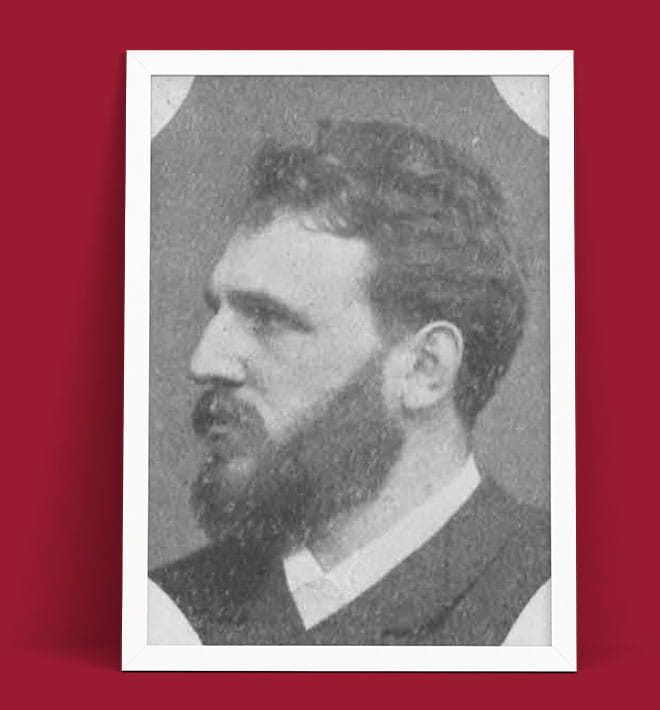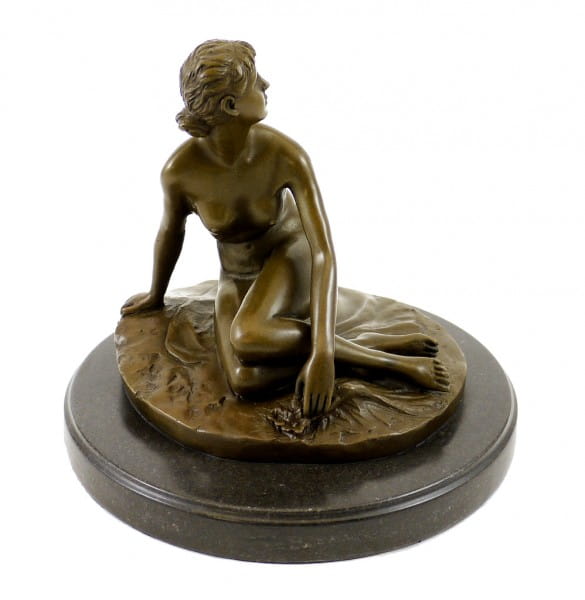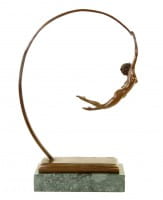Prices incl. VAT, free shipping worldwide
Ready to ship today,
Delivery time appr. 3-6 workdays










Product description
"Art Nouveau Statue (1881) - Spring - Peter Breuer Bronze"
| Height | 15 cm |
| Width | 15 cm |
| Length | 15 cm |
| Weight | 2,3 kg |
Art Nouveau Bronze Figure (1881) - Spring - Signed Peter Breuer
With its grace, delicacy, and sculptural poise, Peter Breuer’s “Spring” (1881) captures the transition of 19th-century European sculpture into the aesthetic world of early modernism. This elegant Art Nouveau bronze figure, signed by the artist and executed with exceptional finesse, represents not only the poetic vision of feminine beauty but also the refined technical and stylistic mastery that defined Breuer’s long and influential career. The sculpture depicts a young woman caught in a moment of contemplative motion—her posture alert yet gentle, her gaze turned thoughtfully to the side. Draped in a subtly clinging cloth and seated in a pose of balanced relaxation, she embodies both serenity and vitality, becoming a timeless personification of rebirth and renewal. The work, both allegorical and sensual, is one of the earliest and most evocative examples of Peter Breuer bronze, bridging the gap between 19th-century naturalism and the floral elegance of Art Nouveau.
A Sculptor Between Eras
Peter Breuer was born on May 18, 1856, in Cologne, Germany. Educated at the prestigious Berlin Academy of Arts under the sculptor Albert Wolff, Breuer emerged as one of the leading figures in German academic sculpture in the late 19th century. Yet unlike many of his contemporaries who remained strictly committed to monumental classicism, Breuer demonstrated an early interest in psychological nuance, surface refinement, and narrative intimacy—qualities that would later resonate with the ideals of Art Nouveau. His works, ranging from public monuments to private bronzes, reveal a sculptor capable of both grand gestures and subtle emotional inflection. Peter Breuer bronze pieces are prized for their technical perfection, lyrical quality, and timeless character, of which “Spring” is a radiant example.
Berlin, 1881 – A Work of Poetic Modernity
Created in 1881 in Berlin, “Spring” emerges from the artist’s early mature period, when he had already begun to distinguish himself from the academic mainstream. While deeply rooted in the traditions of the Beaux-Arts school, the sculpture breaks away from rigid formality through its emotional sensitivity and flowing lines. The work is not content with passive representation—it aspires to capture a state of being, a moment suspended between movement and stillness. In this way, Peter Breuer bronze anticipates the stylistic currents that would soon sweep through European decorative arts. Although predating the peak of Art Nouveau by over a decade, “Spring” already possesses many of its hallmarks: fluid drapery, natural forms, feminine elegance, and symbolic suggestion.
The Feminine as Allegory and Emotion
In “Spring”, the female figure becomes both an individual and an idea. She is not a classical goddess nor a mythological archetype but something more immediate and earthly. Her body, softly modeled, leans gently on one hand while her legs are arranged with casual precision. Her torso twists slightly, creating a dynamic but serene rhythm across her form. The position of her hands and the backward glance of her head suggest both inner reflection and awakening. This Art Nouveau bronze figure does not shout symbolism—it whispers it. She is “Spring” not because of overt iconography, but because of how she feels—young, fluid, open, aware. The emotional language is tactile, subtle, and deeply human.
The Surface as a Language of Sensation
The finish and treatment of the bronze surface exemplify Breuer’s mastery in translating emotion into form. The patina is warm and soft, giving the figure a sense of vitality and breath. Every detail—whether the slight tension in her shoulder, the gentle curve of her fingers, or the folds of the cloth beneath her—has been modeled with immense care, creating a visual and tactile rhythm that invites slow, intimate viewing. This is a hallmark of Peter Breuer bronze: the transformation of metal into living presence. The play of light across her skin, the way shadows gather in the folds of the base, and the polished flow of the torso all combine to create a sculpture that exists not just in space, but in mood.
A Moment Suspended in Time
Unlike many 19th-century female nudes that functioned as mythological allegories or decorative objects, “Spring” exists in a quiet moment of introspection. It is neither idealized nor eroticized in a superficial way. Rather, it radiates a kind of inner luminosity—rooted in grace, but never ornamental. The woman is not posed for display; she is absorbed in her own world. This sense of self-contained beauty elevates “Spring” beyond mere representation and places it firmly in the lineage of emotionally resonant art nouveau bronze sculpture.
The Enduring Legacy of Peter Breuer
Peter Breuer continued to produce major public monuments and private sculptures until his death in Berlin in 1930. He was a professor at the Berlin Academy and served as mentor to a generation of young sculptors who would carry forward his attention to anatomical precision and expressive clarity. While his large-scale works remain visible in city squares and cemeteries throughout Germany, it is in his smaller bronzes—like “Spring”—that his lyrical sensibility finds its purest form. These works reveal the essential qualities of Peter Breuer bronze: an unforced elegance, a reverence for the human figure, and a talent for capturing the soul within the surface.
A Testament to Quiet Emotion and Sculptural Grace
“Spring” is not a spectacle. It is an intimate bronze that invites reflection rather than proclamation. It reminds the viewer that beauty lies not in grand myth but in gestures, in breath, in pause. As a rare and early art nouveau bronze figure, it bridges the neoclassical and the modern, combining sculptural precision with lyrical warmth. It is an enduring embodiment of Peter Breuer’s artistic philosophy: that sculpture, at its highest level, is a dialogue between form and feeling. In “Spring”, that dialogue becomes a whisper, an offering, and a celebration of eternal feminine grace.
Our advantages
free shipping
Worldwide free shipping
14 days money back
You can cancel your order
within 14 days
secure payment services
Paypal, Master Card, Visa, American Express and more



























































